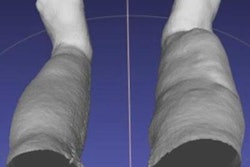
CHICAGO - The gaming console your children use to destroy alien villains on distant fictional planets may help radiologists improve the quality of x-rays, researchers reported at RSNA 2015.
They suggested that the Microsoft Kinect console, a motion-sensing device that is often used with Xbox video games, can be adapted to detect patient motion, determine target organs, enhance correct beam positioning, and even measure body thickness.
"Patients, technologists, and radiologists want the best-quality x-rays at the lowest dose possible without repeating images," said Dr. Steven Don, an associate professor of radiology at Washington University School of Medicine. "This technology is a tool to help achieve that goal. Patients will benefit from reduced radiation exposure and higher-quality images to ensure diagnostic accuracy."
Don said that the researchers could probably build a console on their own, but the Kinect hardware, when combined with their own proprietary software, "is fairly well-packaged and integrated."
In the feasibility study described at the RSNA press conference, the researchers mounted the gaming console on an x-ray tube, allowing for measurement of body-part thickness automatically. The system can identify body parts, detect whether the anatomy is within the x-ray field-of-view, and measure real-time motion.
This should translate into reduced retake rates, improved image quality, and less radiation dose, Don said.
Microsoft Kinect was originally developed as a motion sensor and facial and voice recognition device for the Xbox gaming system that enabled players to play games without a standard controller. Subsequently, the technology has been adapted for select nongaming applications, Don said.
"To optimize radiation exposure and image quality, x-ray technique should be set based on body-part thickness," he said. "Use of traditional calipers is time-consuming, intrusive, and sometimes frightening to young children. Using Microsoft Kinect with this software, we can measure body-part thickness automatically without patient contact."
He suggested that the device could inform technicians if a patient moves after being positioned. Such movements can lead to multiple scans, increasing time and radiation exposure, whereas the system could detect the motion before x-ray exposure.
Don said his preclinical research is continuing with the updated Kinect 2.0 system, and researchers are investigating if the device can improve imaging with CT and fluoroscopy studies.
"In the future, we hope to see this device and other tools like it installed on radiography equipment to aid technologists by identifying potential problems before they occur," he said.
Commenting on the study, moderator Dr. Gary Whitman, a professor of radiology at MD Anderson Cancer Center, said, "Having the right exam with the right acquisition is important for the radiologist. Our technicians spend an inordinate amount of time making sure that it is the right exam being performed on the right patient. Being able to identify motion would really help in efficiency."
Whitman said he was not previously aware of the gaming system being adapted for use in the radiology suite.
"Even though this is a preliminary report, I think it has a future," he said.



















